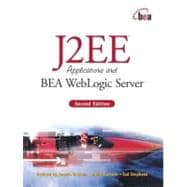
| Preface | |
| Acknowledgments | |
| Overview | |
| WebLogic Server and J2EE | |
| J2EE Technologies Covered in This Book | |
| Presentation Logic | |
| Database and Transaction Support | |
| Object Registry and Remote Method Invocation | |
| Enterprise JavaBeans | |
| Java Message Service | |
| JavaMail | |
| Administration | |
| Security | |
| WebLogic Server's Distributed Deployment Support | |
| About WebAuction | |
| WebLogic Platform 8.1 | |
| Presentation Logic | |
| Presentation Logic | |
| Introducing Servlets | |
| The Web Application | |
| Best Practices for Servlets | |
| References | |
| Advanced Servlet Techniques | |
| Servlets and Web Sessions | |
| Baking Your Own Cookies | |
| Filters | |
| Using Servlets with WebLogic Server Clustering | |
| Best Practices for Servlets | |
| Resources | |
| Putting It All Together | |
| Using WebLogic Server JavaServer Pages | |
| Why JSP | |
| Integrating Java Code and JSP Markup | |
| JSP Basics | |
| Custom tags | |
| References | |
| WebLogic Server JDBC and JTA | |
| WebLogic Server JDBC | |
| Transactions and JTA | |
| WebLogic Server and Distributed Transactions | |
| Prepared Statements | |
| Error Handling and SQL Warnings | |
| Metadata | |
| Advanced JDBC Features | |
| Best Practices for JDBC | |
| JDBC and Transactions in the WebAuction Application | |
| Summing It Up | |
| Remote Method Invocation and Distributed Naming | |
| Remote Method Invocation | |
| JNDI: Java's Naming Service | |
| Conclusion | |
| References | |
| Enterprise Messaging with the Java Message Service (JMS) | |
| JMS Fundamentals | |
| Sample JMS Queue Producer/Consumer | |
| JMS Messages | |
| Message Types | |
| JMS and Transactions | |
| Clustering JMS | |
| Exception Listeners | |
| Using Multicast JMS | |
| JMS Best Practices | |
| Putting It All Together | |
| References | |
| Using Session Enterprise JavaBeans | |
| Enterprise JavaBeans Overview | |
| Basics of EJBs | |
| Stateless Session EJBs | |
| Stateful Session EJBs | |
| Using Transactions with Session Beans | |
| EJB Security | |
| EJB Environment | |
| EJB References | |
| Resource Manager References | |
| Handles | |
| Development Tasks and WebLogic Workshop | |
| Best Practices | |
| Putting It All Together | |
| References | |
| Entity EJBs | |
| Rationale for Entity EJBs | |
| Entity Bean Basics | |
| CMP Entity Bean Example | |
| CMP | |
| Container-Managed Entity Bean Lifecycle | |
| Introduction to CMRs | |
| Writing EJB-QL for CMP Finders | |
| BMP Entity Beans | |
| Advanced Topics for Writing Entity EJBs | |
| Entity Bean Inheritance and Polymorphism | |
| Entity Beans and Locking | |
| Using Read-Only Entity Beans | |
| Session Beans as a Wrapper for Entity Beans | |
| Using Java Beans as Value Objects | |
| BMP Versus CMP | |
| Putting It All Together | |
| References | |
| Using Message-Driven EJBs | |
| Message-Driven EJB Basics | |
| Message-Driven EJB Example | |
| MDBs and Concurrency | |
| Specifying a JMS Connection Factory | |
| Using Transactions with MDBs | |
| Message Acknowledgment | |
| New Customer Example | |
| Using JMS for Communication with Enterprise Systems | |
| Message-Driven EJB Advantages | |
| Putting It All Together | |
| References | |
| 11 | |
| About E-mail | |
| About JavaMail | |
| Using JavaMail to Send Simple E-mail | |
| Where to Find More Information on JavaMail and Internet Mail | |
| JavaMail Best Practices | |
| Administering WebLogic Server 8.1 | |
| Java Management Extensions Overview | |
| WebLogic Server Administration | |
| WebLogic Administrative Tools | |
| Application Deployment | |
| WebLogic Service Performance Monitor | |
| WebLogic Clustering Configuration | |
| Administrative Best Practices | |
| Putti | |
| Table of Contents provided by Publisher. All Rights Reserved. |
The New copy of this book will include any supplemental materials advertised. Please check the title of the book to determine if it should include any access cards, study guides, lab manuals, CDs, etc.
The Used, Rental and eBook copies of this book are not guaranteed to include any supplemental materials. Typically, only the book itself is included. This is true even if the title states it includes any access cards, study guides, lab manuals, CDs, etc.